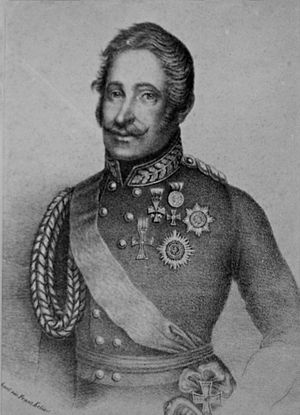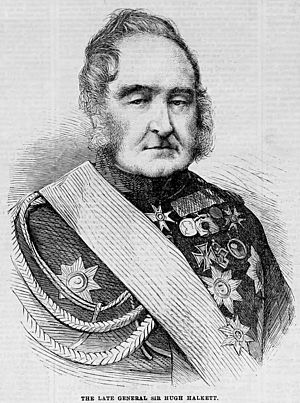Hugh Halkett facts for kids
General Baron Hugh Halkett (born August 30, 1783, in Musselburgh, Scotland – died December 10, 1863, in Hanover, Germany) was a brave British soldier. He fought during the Napoleonic Wars, which were big wars in Europe. Later, he became a general in the army of the Kingdom of Hanover, which was a German kingdom.
Contents
Early Life and Military Start
Hugh Halkett was born in Scotland. He was the second son of Major-General F. G. Halkett. His brother, Colin Halkett, also became a famous general.
From 1798 to 1801, Hugh served in India. He was part of the Scottish Brigade, a military unit that his father helped create.
In 1803, Hugh joined the 2nd Light Infantry Battalion. This was a new unit called the King's German Legion (KGL). The KGL was a special German army unit that fought for Britain. His brother Colin was in charge of this battalion.
Fighting in Europe
The 2nd Light Infantry took part in military trips to Hanover, Rügen, and Copenhagen. During this time, Hugh was promoted to major. His brave actions while on guard duty earned him special praise.
From 1808 to 1813, Halkett fought in the Peninsular War. This was a war in Spain and Portugal. In 1809, he also joined the Walcheren Expedition, another military operation.
He fought bravely at the Battle of Albuera. When his brother was promoted, Hugh took command of the 2nd Light Infantry Battalion. At the Battle of Salamanca, his battalion was part of the 7th Division. He showed great courage during the Siege of Burgos campaign, especially at the Battle of Venta del Pozo.
In 1813, he joined the new Hanoverian Army. He led a group of Hanoverian soldiers at the Battle of the Göhrde. He even captured a Danish flag during a fight at Sehestedt.
Hero at Waterloo and Later Career
At the famous Battle of Waterloo, Halkett led four groups of Hanoverian landwehr (militia soldiers). These groups were sent to the front lines with the regular soldiers. His group was kept in reserve on the right side for most of the battle.
After Napoleon's Imperial Guard was defeated, the Duke of Wellington sent Halkett to chase the French army. Halkett is famous for capturing General Pierre Cambronne. This happened while his Osnabrück Battalion fought the French Imperial Guard.
After Waterloo, Halkett continued to serve in the Hanoverian army. He became a general and the inspector-general of all infantry soldiers. He led a Federal Army Corps in the First War of Schleswig in 1848. He defeated the Danes at the Battle of Oeversee.
Halkett received many important awards from other countries. These included the Prussian Order of the Black Eagle and the Pour le Mérite. He also received the Russian Order of St. Anna. In 1815, he was made a Knight Commander of the Royal Guelphic Order. He was promoted to Knight Grand Cross in 1851. In 1862, King George V of Hanover made him a noble, giving him the title of Freiherr (Baron).
Family
Hugh Halkett married Emilia Charlotte on May 25, 1810. She was the daughter of Sir James Lamb, 1st Baronet.
See also
 In Spanish: Hugh Halkett para niños
In Spanish: Hugh Halkett para niños



